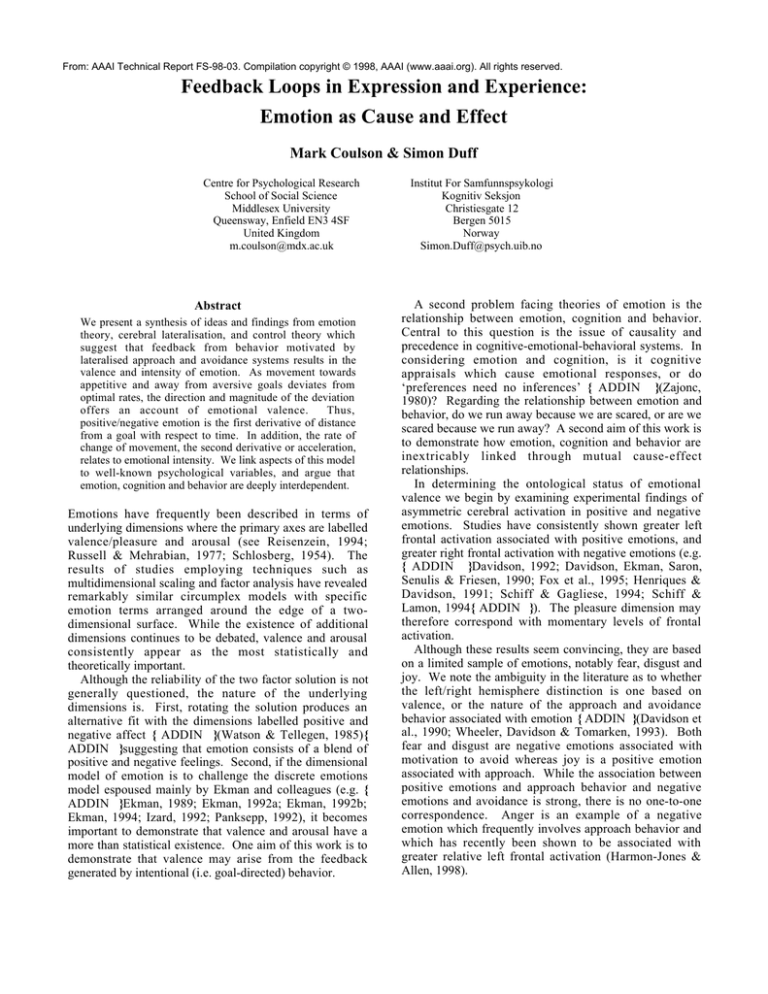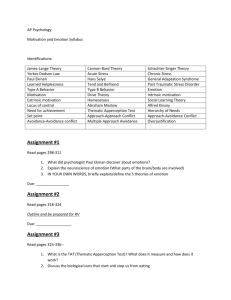
From: AAAI Technical Report FS-98-03. Compilation copyright © 1998, AAAI (www.aaai.org). All rights reserved.
Feedback Loops in Expression and Experience:
Emotion as Cause and Effect
Mark Coulson & Simon Duff
Centre for Psychological Research
School of Social Science
Middlesex University
Queensway, Enfield EN3 4SF
United Kingdom
m.coulson@mdx.ac.uk
Abstract
We present a synthesis of ideas and findings from emotion
theory, cerebral lateralisation, and control theory which
suggest that feedback from behavior motivated by
lateralised approach and avoidance systems results in the
valence and intensity of emotion. As movement towards
appetitive and away from aversive goals deviates from
optimal rates, the direction and magnitude of the deviation
offers an account of emotional valence.
Thus,
positive/negative emotion is the first derivative of distance
from a goal with respect to time. In addition, the rate of
change of movement, the second derivative or acceleration,
relates to emotional intensity. We link aspects of this model
to well-known psychological variables, and argue that
emotion, cognition and behavior are deeply interdependent.
Emotions have frequently been described in terms of
underlying dimensions where the primary axes are labelled
valence/pleasure and arousal (see Reisenzein, 1994;
Russell & Mehrabian, 1977; Schlosberg, 1954). The
results of studies employing techniques such as
multidimensional scaling and factor analysis have revealed
remarkably similar circumplex models with specific
emotion terms arranged around the edge of a twodimensional surface. While the existence of additional
dimensions continues to be debated, valence and arousal
consistently appear as the most statistically and
theoretically important.
Although the reliability of the two factor solution is not
generally questioned, the nature of the underlying
dimensions is. First, rotating the solution produces an
alternative fit with the dimensions labelled positive and
negative affect { ADDIN }(Watson & Tellegen, 1985){
ADDIN }suggesting that emotion consists of a blend of
positive and negative feelings. Second, if the dimensional
model of emotion is to challenge the discrete emotions
model espoused mainly by Ekman and colleagues (e.g. {
ADDIN }Ekman, 1989; Ekman, 1992a; Ekman, 1992b;
Ekman, 1994; Izard, 1992; Panksepp, 1992), it becomes
important to demonstrate that valence and arousal have a
more than statistical existence. One aim of this work is to
demonstrate that valence may arise from the feedback
generated by intentional (i.e. goal-directed) behavior.
Institut For Samfunnspsykologi
Kognitiv Seksjon
Christiesgate 12
Bergen 5015
Norway
Simon.Duff@psych.uib.no
A second problem facing theories of emotion is the
relationship between emotion, cognition and behavior.
Central to this question is the issue of causality and
precedence in cognitive-emotional-behavioral systems. In
considering emotion and cognition, is it cognitive
appraisals which cause emotional responses, or do
‘preferences need no inferences’ { ADDIN }(Zajonc,
1980)? Regarding the relationship between emotion and
behavior, do we run away because we are scared, or are we
scared because we run away? A second aim of this work is
to demonstrate how emotion, cognition and behavior are
inextricably linked through mutual cause-effect
relationships.
In determining the ontological status of emotional
valence we begin by examining experimental findings of
asymmetric cerebral activation in positive and negative
emotions. Studies have consistently shown greater left
frontal activation associated with positive emotions, and
greater right frontal activation with negative emotions (e.g.
{ ADDIN }Davidson, 1992; Davidson, Ekman, Saron,
Senulis & Friesen, 1990; Fox et al., 1995; Henriques &
Davidson, 1991; Schiff & Gagliese, 1994; Schiff &
Lamon, 1994{ ADDIN }). The pleasure dimension may
therefore correspond with momentary levels of frontal
activation.
Although these results seem convincing, they are based
on a limited sample of emotions, notably fear, disgust and
joy. We note the ambiguity in the literature as to whether
the left/right hemisphere distinction is one based on
valence, or the nature of the approach and avoidance
behavior associated with emotion { ADDIN }(Davidson et
al., 1990; Wheeler, Davidson & Tomarken, 1993). Both
fear and disgust are negative emotions associated with
motivation to avoid whereas joy is a positive emotion
associated with approach. While the association between
positive emotions and approach behavior and negative
emotions and avoidance is strong, there is no one-to-one
correspondence. Anger is an example of a negative
emotion which frequently involves approach behavior and
which has recently been shown to be associated with
greater relative left frontal activation (Harmon-Jones &
Allen, 1998).
Carver & Scheier (1990), adopting a control theory
approach, argue that satisfaction, and hence emotion, can
be modelled as the output of a system designed to reduce
distance to a goal. Through negative feedback the system
acts to maintain the rate of approach at some optimal value.
When the actual rate falls below this, negative emotion is
experienced and restorative action initiated which directs
resources towards attaining the goal. When progress is
greater than required, positive emotion occurs and triggers
behavior redirecting resources away from the goal. There
is some evidence which suggests outcome satisfaction is
related to average rate of approach { ADDIN }(Hsee &
Abelson, 1991; Hsee, Salovey & Abelson, 1994).
The proposed model offers an account of the relationship
between emotional valence and behavior, embraces the
notion of emotional intentionality, and provides an
explanation for the transitory nature of emotion. Emotions
concern goal-directed activity in the context of a
homeostatic system acting to motivate behaviors that
remove the cause of the emotion. Emotional valence is
therefore both cause and effect of intentional behavior.
In addition to modelling emotional valence, we argue
that the second derivative of distance, acceleration, is a
candidate for emotional intensity. The intensity of good
and bad feelings depends not on the rate of progress, but on
the rate at which this changes. We suggest that the optimal
level for this variable is generally zero.
Although the scheme as proposed is incomplete, its
formality makes it capable of rigorous investigation.
Furthermore, several features of the model can be mapped
onto areas of psychological theory. For instance, error
sensitivity (the degree to which restorative behavior is
motivated by discrepancies between actual and ideal
values) maps closely onto neuroticism, and the rate at
which sampling occurs may directly affect the degree of
fluctuation in the system, its ‘moodiness’.
We conclude by arguing that the control theory approach
circumvents the Zajonc-Lazarus precedence debate by
illustrating the inextricable circularity of emotion,
cognition and behavior. Emotion, at least in terms of
valence and intensity, arises as a direct result of behavior,
but then acts to modify that behavior through perception
and inference. None of these systems can act in isolation
from the others.
References
{ ADDIN } Davidson, R. J. (1992). Anterior cerebral
asymmetry and the nature of emotion. Brain and Cognition,
20, 125-151.
Davidson, R. J., Ekman, P., Saron, C. D., Senulis, J. A.,
& Friesen, W. V. (1990). Approach-withdrawal and
cerebral asymmetry: Emotional expression and brain
physiology I. Journal of Personality and Social
Psychology, 58 , 330-341.
Ekman, P. (1989). The argument and evidence about
universals in facial expressions of emotion. In H. W. A.
Manstead (Ed.), Handbook of social psychophysiology , .
Chichester, England: Wiley.
Ekman, P. (1992a). Are there basic emotions?
Psychological Review, 99, 550-553.
Ekman, P. (1992b). An argument for basic emotions.
Cognition and Emotion, 6, 169-200.
Ekman, P. (1994). Strong evidence for universals in
facial expressions: A reply to Russell’s mistaken critique.
Psychological Bulletin, 115, 268-287.
Fox, N. A., Coplan, R. J., Rubin, K. H., Porges, S. W.,
Calkins, S. D., Long, J. M., Marshall, T. R., & Stewart, S.
(1995). Frontal activation asymmetry and social
competence at four years of age. Child Development, 66 ,
1770-1784.
Harmon-Jones, E. & Allen, J. J. B. (1998). Anger and
frontal brain activity: EEG asymmetry consistent with
approach motivation despite negative affective valence.
Journal of Personality and Social Psychology, 74, 13101316
Henriques, J. B., & Davidson, R. J. (1991). Left frontal
hypoactivation in depression. Journal of Abnormal
Psychology, 100 , 535-545.
Hsee, C. K., & Abelson, R. P. (1991). Velocity relation:
Satisfaction as a function of the first derivative of outcome
over time. Journal of Personality and Social Psychology,
60, 341-347.
Hsee, C. K., Salovey, P., & Abelson, R. P. (1994). The
quasi-acceleration relation: Satisfaction as a function of the
change of velocity of outcome over time. Journal of
Experimental Social Psychology, 30 , 96-111.
Izard, C. E. (1992). Basic emotions, relations among
emotions, and emotion-cognition relations. Psychological
Review, 99 , 561-565.
Panksepp, J. (1992). A critical role for “affective
neuroscience” in resolving what is basic about basic
emotions. Psychological Review, 99, 554-560.
Reisenzein, R. (1994). Pleasure-arousal theory and the
intensity of emotions. Journal of Personality and Social
Psychology, 67 , 525-539.
Russell, J. A., & Mehrabian, A. (1977). Evidence for a
three-factor theory of emotions. Journal of Research in
Personality, 11, 273-294.
Schiff, B. B., & Gagliese, L. (1994). The consequences
of experimentally induced and chronic unilateral pain:
Reflections of hemispheric lateralization of emotion.
Cortex, 30, 255-267.
Schiff, B. B., & Lamon, M. (1994). Inducing emotion by
unilateral contraction of hand muscles. Cortex, 30, 247-254
Schlosberg, H. (1954). Three dimensions of emotion.
Psychological Review, 61, 81-88.
Watson, D., & Tellegen, A. (1985). Toward a consensual
structure of mood. Psychological Bulletin, 98, 219-235.
Wheeler, R. E., Davidson, R. J., & Tomarken, A. J.
(1993). Frontal brain asymmetry and emotional reactivity:
A biological substrate of affective style. Psychophysiology,
30, 82-89.
Zajonc, R. B. (1980). Feeling and thinking: Preferences
need no inferences. American Psychologist, 35, 151-175.







